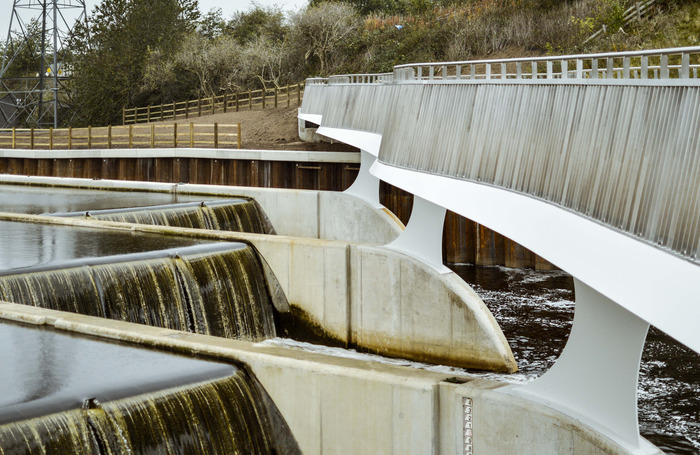Good design can take infrastructure projects beyond providing mere utility to creating great public spaces. Walk around the transformed King’s Cross in London or Birmingham New Street and see the case for marrying placemaking and infrastructure through a design-led approach.
Embedding this thinking at the outset of infrastructure projects, however, remains a challenge. Petra Marko, co-founder of Marko&Placemakers, admits that even as an architect focussed on the public realm it is difficult to quantify the added value of successful public spaces for clients.

Case studies help to get the quality message across. Commissioned by the National Infrastructure Commission’s Design Task Force to co-author (with Judith Sykes of Expedition Engineering) a showcase of projects that illustrate how good design benefits infrastructure projects, often adding great public amenity in the process, Marko published ‘The Value of Design in Infrastructure Delivery’ last week.
‘The findings show that successful infrastructure projects need client design leadership and up-front investment to reduce risk and achieve cost certainty while delivering multiple benefits beyond mere utility. Innovative design outcomes rely on a truly collaborative effort between client, design and contractor teams,’ says Marko.
‘Great infrastructure projects are people-focused, creating a pleasant customer experience as well as wider economic and social benefits to local communities, connecting to the surrounding public realm and the place. We also found that a truly sustainable approach is the result of a fully integrated design process rather than technological gimmicks.’
But the Design Task Force identified a lack of clarity among those delivering infrastructure projects about the meaning of good design, along with a deep-seated suspicion that it would add to cost and complexity.
Asked to name a stand out example of a project that delivered beyond functional infrastructure, Marko cites Rotterdam Centraal Station by Benthem Crouwel Architects, MVSA Meyer en Van Schooten Architecten and West 8, which accommodates different stakeholder requirements and managed typical conflicts arising in a major transport hub project within a successfully integrated piece of urban design.
The new station, which has transformed a formerly cut-off area of the city into a civic plaza and new gateway to Rotterdam, is one of series of show stopper projects that has helped the Netherland’s second city cast off its gritty port image and be dubbed “the Dutch Brooklyn”.
At a more modest scale, Marko points to the Pudding Mill sewage pump station in the London Olympic Park by Lyall Bills & Young Architects. The design team completely re-engineered the above ground building as part of an integrated design approach to landscape, streetscape and art – Joseph Bazalgette’s original engineering drawings in relief on the external façade.
She also lauds Leeds City Council, which commissioned the Knostrop footbridge in Leeds by Knight Architects as part of the Leeds Flood Alleviation Scheme, for recognising that a high-quality bridge could attract users and promote active commuting.
Marko and Kay Hughes, Director of Khaa, will be discussing how to approach successful placemaking in infrastructure at the RIBA’s Smart Practice Conference 2018 in October. Both were part of the winning team for the NIC’s ideas competition for the ‘growth arc’ of Oxford-Milton Keynes-Cambridge. The all-female VeloCity team proposed a series of new communities along the route of the proposed East West Rail line, planned to maximise opportunities for cycling and walking to reduce reliance on cars.
Hughes’s extensive client-side experience as a design adviser includes work for Sport England, Arts Council England and the London Olympics.
Asked about the value architects can bring to the design or briefing for infrastructure projects, she explains that architects are able to see the links between the services we need and the quality of the environment that we all enjoy individually or jointly.
She emphasises integrating infrastructure functions while looking for the win-win solution: ‘It is easy for individual sectors to become focused on their own needs and business model. It is challenging working with individual companies with their own agendas. But setting the problem of how they can achieve the bigger picture, the integrated spaces and places that we all enjoy, is essential.’
The notion of infrastructure is not limited to high technology. Some of the most sustainable infrastructure approaches are based on ecological systems that deliver multiple benefits at once, such as water management systems using swale and SUDS drainage instead of hard engineering and underground piping.
‘Value is about integrating functions and looking for a win-win. It is not about doing the same as you have always done, it requires lateral thinking about the issues to be addressed and the technology available.’
Value Added: Making Design Quality Count, the RIBA Smart Practice Conference 2018, takes place at Fitzwilliam College, Cambridge on 4 October 2018. Special Early Bird rate tickets are now available.
Thanks to Petra Marko, Co-founder, Marko&Placemakers; Kay Hughes, Director, Khaa.
Text by Neal Morris. This is a Professional Feature edited by the RIBA Practice team. Send us your feedback and ideas
RIBA Core Curriculum Topic: Places, planning and communities.
As part of the flexible RIBA CPD programme, Professional Features count as microlearning. See further information on the updated RIBA CPD Core Curriculum and on fulfilling your CPD requirements as an RIBA Chartered Member.
Posted on 12 July 2018.









